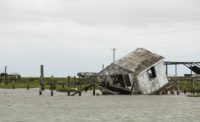California officials hope to soon begin holding public meetings to gather information for a sea-level-rise assessment report that Gov. Arnold Schwarzenegger (R) has asked the National Academy of Sciences to prepare by Dec. 1, 2010. But finding money for the contract is an issue.
Schwarzenegger asked the academy in November to convene a panel with representatives from the state’s resources agency, department of water resources, energy commission, coastal commission, ocean protection council and others to plan for sea-level rise. The report is to include sea-level-rise projections—with the range of uncertainty—the probable impact on state infrastructure and an assessment of research needs.
Gregory Symmes, deputy executive director of NAS’s division of earth and life studies, says a contract for the report is being negotiated. “We’re very excited about doing such a study,” he says.
Boniface Bigornia, vice president of Arcadis US Inc., Denver, says he hopes to see a master plan like the draft report of the “Louisiana Coastal Protection and Restoration Report” that the U.S. Army Corps of Engineers submitted for NAS review in March. Walnut Creek, Calif.-based Bigornia is developing Arcadis’ flood-risk management program nationwide and in California, where the company is a consultant to Kleinfelder Inc., San Diego., on a $120-million state contract to evaluate 380 miles of non-urban levees on the San Joaquin River. They are awaiting a start order, which is also delayed by the state’s fiscal crisis.
“If you look at LACPR, one of its strengths is shared vision—collaboration where everyone sits around a table and negotiates,” Bigornia says. “Engineering technology will help decision-makers trade off a little more easily and transparently than in the past.”
As the nation discovered when Hurricane Katrina overwhelmed New Orleans flood defenses in 2005, a systems approach to water resource management is critical, Bigornia says. “What happens in the San Joaquin River affects the delta, San Francisco Bay and southern California,” he says. But there are multitudes of fractious, conflicting interests. “If you look at the delta, there may be 200 agencies with authority,” he says. Environmentalists want water to stay in the delta to protect endangered species, but municipalities and agricultural interests want water, too. “Then you have flood-control interests on top of that,” Bigornia says.
Structural fixes may only be a part of the overall solution, but levee assessment is a key component to identifying risk and communicating that to stakeholders, Bigornia says. “The current 100-year floodplain designation is really a misnomer,” he adds. “There really is no flood protection. It’s risk management.”



